The Mandalorian: Season 2 Case Study

Case Study
The Mandalorian’s second season promised to expand on the world Jon Favreau and team established in the Disney+ show’s first outing, and it certainly did its job with new creatures, surprise characters, and a host of alien worlds that detail a side of the Star Wars universe not yet realized on film.
The Mandalorian’s second season promised to expand on the world Jon Favreau and team established in the Disney+ show’s first outing, and it certainly did its job. Setting a new standard for an episodic spectacle, the follow-up introduced new creatures, surprise characters, and a host of alien worlds that detail a side of the Star Wars universe not yet realized on film. Learn how the Image Engine team created deadly man-eating arachnids, set the scene for Boba Fett’s return, and created vast ship-breaking prison yards for a television series unlike any other. After all, this is the way.
Released in 2019 alongside the launch of Disney+, the Star Wars spin-off elevated at-home entertainment to a new calibre, featuring a galaxy of planets and aliens brought to life via the latest in virtual production techniques and extraordinary visual effects.
Season two ups the ante: a new host of hostile environments, unscrupulous characters and extraterrestrial threats stand in the way of Din Djarin and his quest to find a home for Grogu, the adorable baby Yoda whose survival could be tied to that of the Jedi. From start to end it’s a season of thrills, revelations, and events that reveal a grittier galaxy far, far away than we’ve ever seen before.
When the offer came to rejoin the crew and commence upon this second adventure with Disney, Image Engine jumped aboard. The team supplied digital stormtroopers, augmented grim Imperial junkyards and conjured up a towering 30ft ice arachnid, all across 516 shots—the result: a sensational follow-up to The Mandalorian’s already stunning season one.
An unscheduled stop
In Episode 2 of The Mandalorian’s second season—”The Passenger”—Din Djarin/Mando ferries a frog-like alien and her unhatched eggs to a neighbouring system. All is well until a routine stop-and-check with two New Republic X-Wings becomes a frantic chase and a crash landing on the planet of Maldo Kreis. Stranded in a cavernous ice cavity, Mando and crew find themselves face to face with a 30 ft “Mother Spider” and her waves of scrabbling younglings.
“The moment the spiders hatch and break through the ice tunnel up until our heroes escape was all our work,” begins Robin Hackl, Visual Effects Supervisor. “The spiders’ threat had to increase as they pursued our heroes through the ice tunnel, into the ice chamber, and finally into the crashed Razor Crest. Maintaining this danger meant thinking about choreography, space, and creature movement across the whole sequence.”


The sequence commences with a moment of quiet: Grogu contentedly eating the contents of a spider egg. The act causes multiple other eggs to hatch and produce a small army of scuttling baby spiders. “We worked on five distinct hatching animations and instanced them randomly throughout the spider nursery,” says Julien Taton, Lead FX TD. “The FX were composed of the egg ripping and curling, the sinewy orificial strands, and the gooey ‘yolk’.”
The spiders emerge from their eggs, joining others of progressively larger size until the Mother crawls from a shadowy cave, revealing her impressively menacing scale. She’s certainly uneasy on the eye, with pale trunk-like legs, a bulging pustule-ridden abdomen, and a pendulous maw fraught with gnashing teeth. “We based the design on Ralph McQuarrie’s unused work from Star Wars: The Empire Strikes Back,” explains Jeremy Mesana, Animation Supervisor. “Our job was to turn up the creepy factor and ground the creature in realism.”
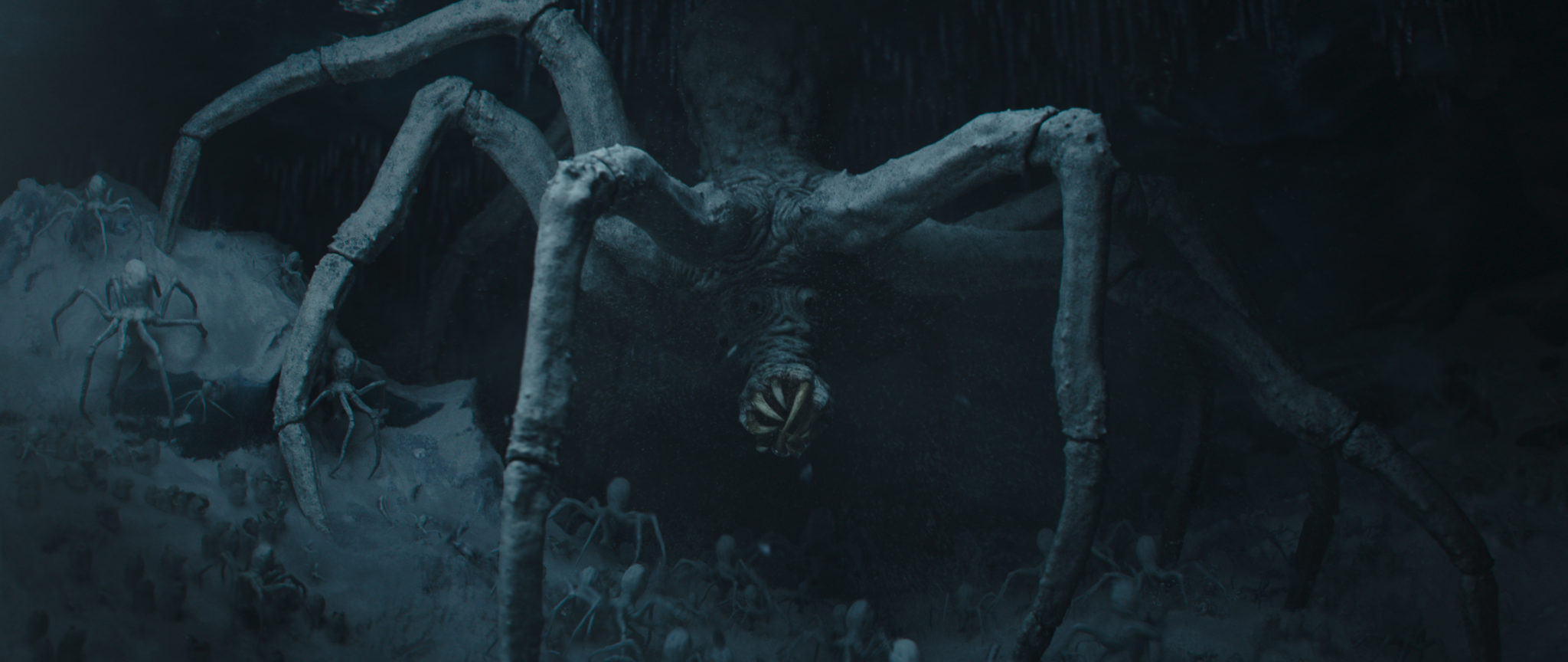
Emily Luk, Senior Texture Artist, started with the shell of a white spider and then layered on snow- and frost-like elements similar to the surrounding environment. “I thought about the spiders’ need to mimic their surroundings for survival. I also added intricate veining and marble patterns and ensured the textures would show in lighting, all while staying true to Peyton’s (Reed, director) vision.”
The creature and its offspring give chase, pursuing their prey through a maze of icy tunnels. For the Mother Spider’s movement, the animation department balanced sheer size with dexterity as the creature scales walls and smashes through obstacles. For the army of variously sized baby spiders, the team opted for a mix of hand-keyed animation and crowd simulation solutions.
Mando and crew reach the crashed Razor Crest and ensconce themselves inside, but quickly realize they remain unsafe as the smaller spiders spill onto the ship and skitter up and over its glass cockpit. Image Engine created each of the scutting creatures, including the silhouettes witnessed through frosted glass.

Hopeful of escaping, Mando attempts to take off, only for the Mother Spider to crash down upon the Razor Crest and pin it to the cavern floor. Image Engine created both this momentous shot and the following, in which the Mother Spider hunkers down and brings her unsettling, pitch-black eyes to bear on Mando and crew through the Razor Crest’s icy glass. She takes in her quarry for a moment before going for the kill, unfurling her maw and slamming it into the Razor Crest cockpit. Here, Image Engine revealed the Mother Spider’s slathering mouth and throat as it smears across the glass, including the creature’s concentric circles of teeth. “We used references from the leatherback turtle, the velvet worm, and the proboscis worm—and of course the Sarlacc Pit monster from Star Wars: Return of the Jedi,” says Rob Jensen.




“The teeth were individually rigged so we could have them moving along with her throat dilations,” adds Jeremy.
Ice tunnels, explosions and spaceships
Creating the ice cave environment itself involved working with plates from three different sets, two of which were shot within ILM’s virtual production LED volume. “The cave environment where the Razor Crest crashes were shot using the LED volume. ILM provided the ‘load’ for this ice tunnel, which we built out at Image Engine,” says Shane Davidson, Compositing Supervisor. “The characters proceed through a practical set decorated with snow columns and then move into the hot spring area, where the Mother Spider appears, which was a second LED volume setup.
The sequence required quick cuts between these varied environments, particularly during the crew’s frantic escape. “We swapped between practical and CG setups fairly liberally as the characters move from the crash site, to ice caves, to the hot springs area, and then back again,” explains Shane. “As Mando and team are pursued back to the ship we start in a LED volume setup, proceed through a practical set, then come out at the crash site volume again, all while Mando shoots fruitlessly at the oncoming horde. The team did a fantastic job in maintaining consistency and continuity across those quick changes.”


Environment work across the plates comprised a mix of full-CG replacement and augmentation of on-set footage. The Image Engine team replaced some background cave ice with CG to add luminosity, for example, allowing illumination of the Mother Spider’s face during hero moments or for the team to play the creature in silhouette.
“We worked toward a middle ground of having the spiders feel real without them blending into the icy background—the audience needed to read them in all the action,” says Greg Massie, Head of Digital Content Creation. “Alex Fuller, Lighting Lead on the sequence, did an amazing job in using shards of light to shape the Mother Spider and blocked light to infer her massive size.”


Alex was also responsible for rendering the ice cave walls—a challenge given the materials had both subsurface and refractive qualities and necessitated 20+ hour rendering times on some frames. “On some shots, it was necessary to refract the Mother Spider through the ice,” says Greg. “He carefully controlled the look, ensuring the ice didn’t look like transparent glass or the opposite extreme of such distortion you couldn’t read what was happening.”


Another layer of complexity came in the tunnel destruction. Several CG ice tunnel shots were required so the FX team could then destroy them as the Mother Spider crashes through rock and Mando throws his grenades. “We added tons of destruction elements to communicate the creature’s depth and power, like chunks of ice and volumetric fire,” says Julien. “We made sure all the elements worked together, such as ensuring the ice pieces wouldn’t act in a way that would diminish the Mother Spider’s scale.”
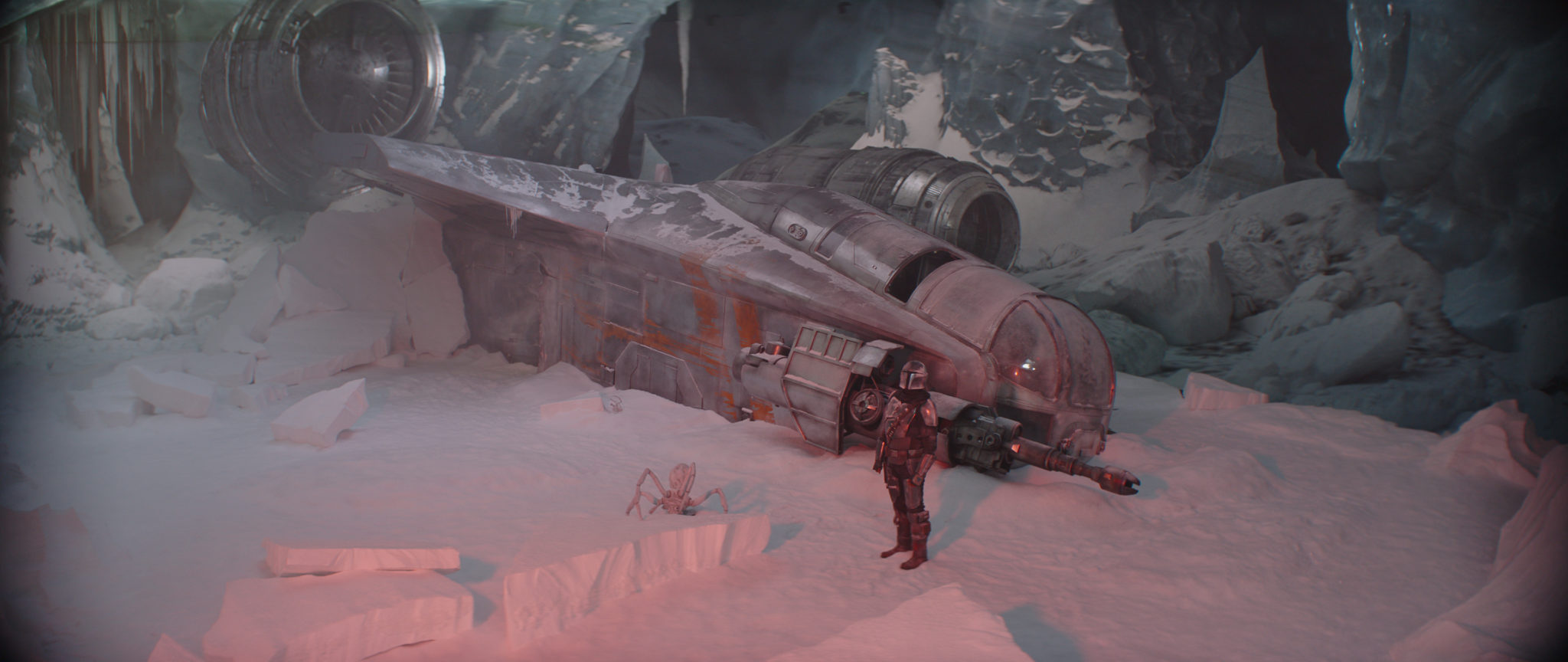

For the crash site location, Image Engine extended the cavern’s height, redressed the set with dead spiders, and added a time of day change as Mando banters with an X-Wing pilot. Both the X-Wing and the Razor Crest were ingested from ILM and then updated by Barry Poon, Asset Supervisor, and his team. “Part of the Razor Crest existed as an on-set damaged version for actor interaction. We created additional damage states for the destruction caused by the Mother Spider. We also updated some X-Wing textures so the asset would hold up in our close-up cockpit shots.”
The Frog Lady
Image Engine also recreated in CG Mando’s eponymous passenger: the Frog Lady. Although the Frog Lady was primarily an on-set practical costume/puppet, specific shots required a digital double. “We added in eye blink shapes, a nictitating membrane, and an extending tongue,” says Barry. “The additions augmented the practical puppet in some shots, whereas other shots required the full digital double.”
Shots such as those when the Frog Lady leaps and bounds away from the attacking Mother Spider. When animating these movements, the team strove to replicate the original Star Wars aesthetic. “We matched our animation to plates of the Frog Lady moving in a prosthetic suit and animatronic head as if a costume hindered her flexibility,” says Jeremy. “We even left in moments during cloth simulation where the Frog Lady’s dress would flap up over her face because it’s physically accurate as to what would happen if someone in a dress leapfrogged down a tunnel.”


The team took a similar approach for the X-Wing take-off at the episode’s end: “The original trilogy created the X-Wings with miniatures, so we added touches of that miniature feel to our flight performance,” says Jeremy.
Welcome back, Boba Fett
Season two’s sixth episode, “The Tragedy”, sees Mando arrive on the planet Tython with Grogu in the hope of contacting the Jedi. The Empire’s Moth Gideon has other plans, however, and sends two stormtrooper dropships to capture Grogu and eliminate the Mandalorian. Little do they know Mando has backup from the mercenary Fennec Shand and—in one of the series’ most crowd-pleasing moments—returning Star Wars fan favourite, Boba Fett.


The resulting firefight was shot on location in California, with director Robert Rodriguez at the helm. “The sequence presented several logistical challenges,” says Robin. “We needed to produce CG shots that cut seamlessly with their surrounding practical plates, animate convincing digital stormtroopers and CG boulders running them down, add a constant barrage of destructive blaster fire, and destroy the Razor Crest. And we did it all with plates filmed at 48 fps.”
Robin adds how hands-on Robert Rodriguez was with the editorial team and in supplying rough first-pass edits Image Engine could use to match timings. “Robert was very involved in the pre-viz process, which informed both the timing and execution of the visual FX work. ‘Follow Robert’s pre-viz’ became something of a mantra.”
A valley of stormtroopers
Although it appears Mando and his team are beset by a platoon of stormtroopers, only six were physically present in the valley—Image Engine added all others. “We ingested the stormtrooper assets from ILM and created several damage states; the main being the helmet smashed in from Boba Fett’s gaffi stick,” says Barry. “We added substantial damage without being too gory or revealing the person under the helmet.”

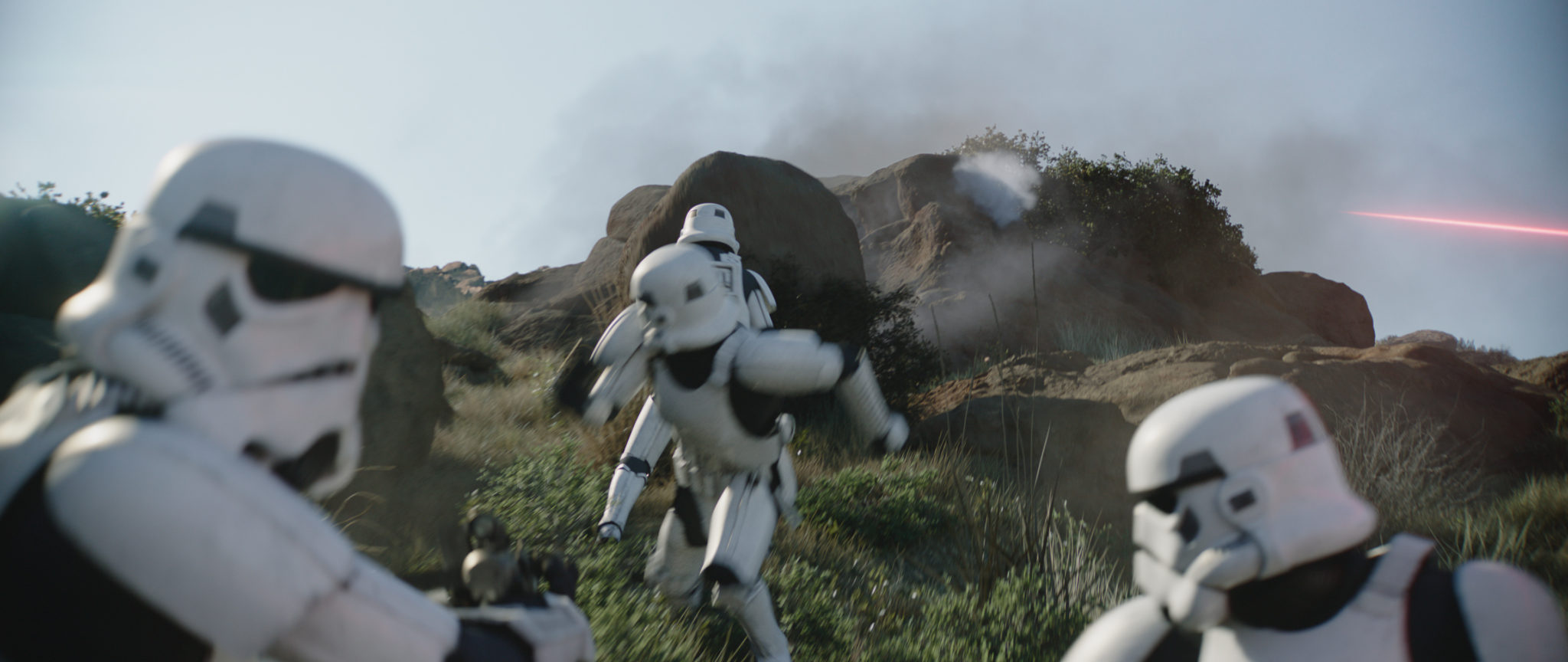
With digital stormtroopers standing next to their live-action counterparts—either in the same shot or in those surrounding—they had to feel indistinguishable from the real thing. “We added things like the CG troopers kicking up digital dust and their digital shadows cast onto the actors,” says Jan Dubberke, Compositing Supervisor. “Blaster impact FX such as sparks and smoke also had to mimic their practical equivalents, which we achieved with both FX and photography.”


The stormtroopers arrive and (attempt to) leave in a pair of CG Imperial dropships created by Image Engine and based on Doug Chiang’s concept art (Lucasfilm Vice President and Executive Creative Director). Image Engine’s work starts with the crafts touching down on Tython: “We added volumes of blowing dust, grit and smoke, and comp integrated dynamically interacting CG vegetation, engine exhaust and heat haze,” says Matt Kiefer, Lighting Lead on episode 6.
Shots in which the stormtroopers spill from the dropships required particular attention. “For one thing, a dolly-backwards shot of CG figures passing through thin CG smoke is a challenging scenario for optimizing a volume render!” says Matt. “Also, although the dropships had a physical analogue on set, it wasn’t the right scale. We matched or took over stormtrooper actors in the plate footage as they exited (or entered) the craft to line up their motions with the CG ship.”
Exploding ships and runaway boulders
Boba Fett’s grand (re)introduction caps off with the bounty hunter destroying both dropships with a well-placed missile shot. The victory is short-lived, however, as a turbolaser blast from Moff Gideon’s light cruiser turns Mando’s Razor Crest into scrap. Image Engine created the subsequent ship-engulfing explosion.
“The razor crest explosion was a big story beat and a creative challenge,” says Cara Davies, Visual Effects Producer. “We had to create slow-motion that looked completely photoreal.”
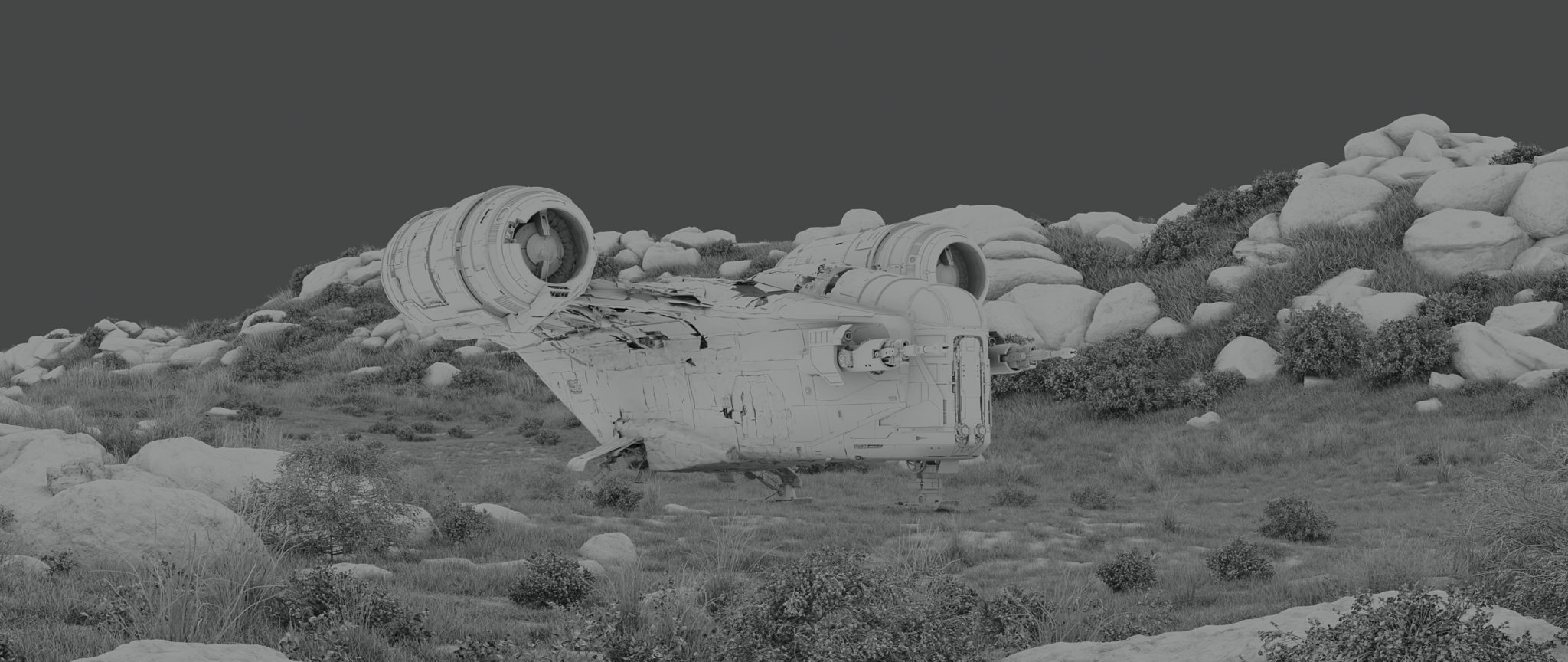

Matt offers more on the sequence’s incredible level of complexity. “Rendering ‘physically accurate’ fire is challenging, and in this instance required many compositing layers. We had many render passes of shrapnel, smoke, fire, dirt and dust. We carefully checked every FX element to see where we could optimize and keep render times at a minimum.”
Another of Image Engine’s story beats was seemingly more straightforward, yet required almost as much thinking as the explosion. “We choreographed a giant boulder tumbling down a hillside crushing all in its path,” explains Jeremy. “The boulder had to look dangerous but also realistic in its movement. Essentially: fun like the boulder roll in Indiana Jones: Raiders of the Lost Ark but without the rails!”


Given the interaction between the characters, boulder, and vegetation, the team opted for an extensive 3D environment build. “We received a lot of on-set photo reference and used it along with photogrammetry models as our base for our build,” says Barry. “We created our master terrain asset and a library of rocks and vegetation that we instanced across the terrain to match the live-action plates.”
“We carefully examined the set around the boulder, matched the boulder to the environment and replaced or reconstructed a great deal of the set for consistency,” adds Matt. “We also decided to add battle damage to the hero boulder quite late in the process, all while iterating on shots that had FX working on impact dust and sparks, and receiving simultaneous updates on the asset from three or more different departments!”
Jan and his team were responsible for many of those extra elements. “We added soil and debris triggered by the huge boulder as it rolls and pummels the stormtroopers and—for consistency—added residual smoke from the gunfight that takes place just previously. The whole sequence was as challenging as it was fun!”
The scrapyard
Image Engine’s third body of work on The Mandalorian season two comes in episode seven—”The Believer”. The episode commences with Mando, Cara Dune, Fennec Shand and Boba Fett landing on the Karthon Chop Fields to recruit Migs Mayfeld—the mercenary Mando clashes with in season one, episode six (also worked on by Image Engine). Karthon’s polluted sky hangs over a machine graveyard, where vast, shuddering crane walkers ferry dead metal and derelict ship skeletons rot.


Image Engine’s work consisted of numerous background fixes, including adding the stop-motion “OI-CT” crane walkers created by Tippett Studio; animating Boba Fett’s much-loved ship, Slave I; and adding in a CG security droid.
The scene was primarily shot within ILM’s LED volume, which aided in much of Image Engine’s background work. “The production crew have zeroed in on where and why they could and should use the LED volume, and this sequence is a prime example of where the methodology shines,” says Hackl. “The prison detention planet is gloomy, polluted and overcast; an ideal lighting scenario as the LED monitor array produces enough light to illuminate the set and characters very effectively. The plates required very little work.
“What I find most interesting about the LED volume process is how early everyone needs to be on the same page to pull this off,” he continues. “Directors, DOPs, set designers, visual effects supervisors and the pre-production CG team must all work seamlessly to execute the work of creating the LED content well before walking into the volume stage on day one of a shoot with actors ready. The process is hugely impressive.”
Slave I, droids and stop motion
Edmond Engelbrecht, CG Supervisor, led the team on several augmentations witnessed throughout the scrap yard sequence. “When loading up Slave I, for instance, we noticed we could see the main glass window from our ramp-down view. We pitched the idea of moving away from the black, ambiguous inside look and rearranged Slave I’s interior to give a little more insight into the ship’s rotating mechanism. Barry and his team also modified the Slave I’s ramp to match the practical ramp used by actors to alight or enter the craft. The Slave I is an iconic star wars ship, after all; we wanted to do it justice.”

Other junkyard augmentations which garnered particular praise from the production: the electrical arcing on the droid’s baton, achieved using an old-school paint solution. Showers of incandescent sparks arcing from various power tools were used to dress up the wide shot to give the impression that workers seen in the sequence filled the landscape.
Image Engine also delivered a CG prison droid, which stomps through an establishing shot of the cluttered junkyard before conversing with Mayfeld. The droid was the same type as that Image Engine delivered in season one, so the team repurposed and updated the asset. “We changed the droid in several ways, such as adding a much darker paint job with more dirt and weathering, given the droid’s murkier environment,” says Barry.

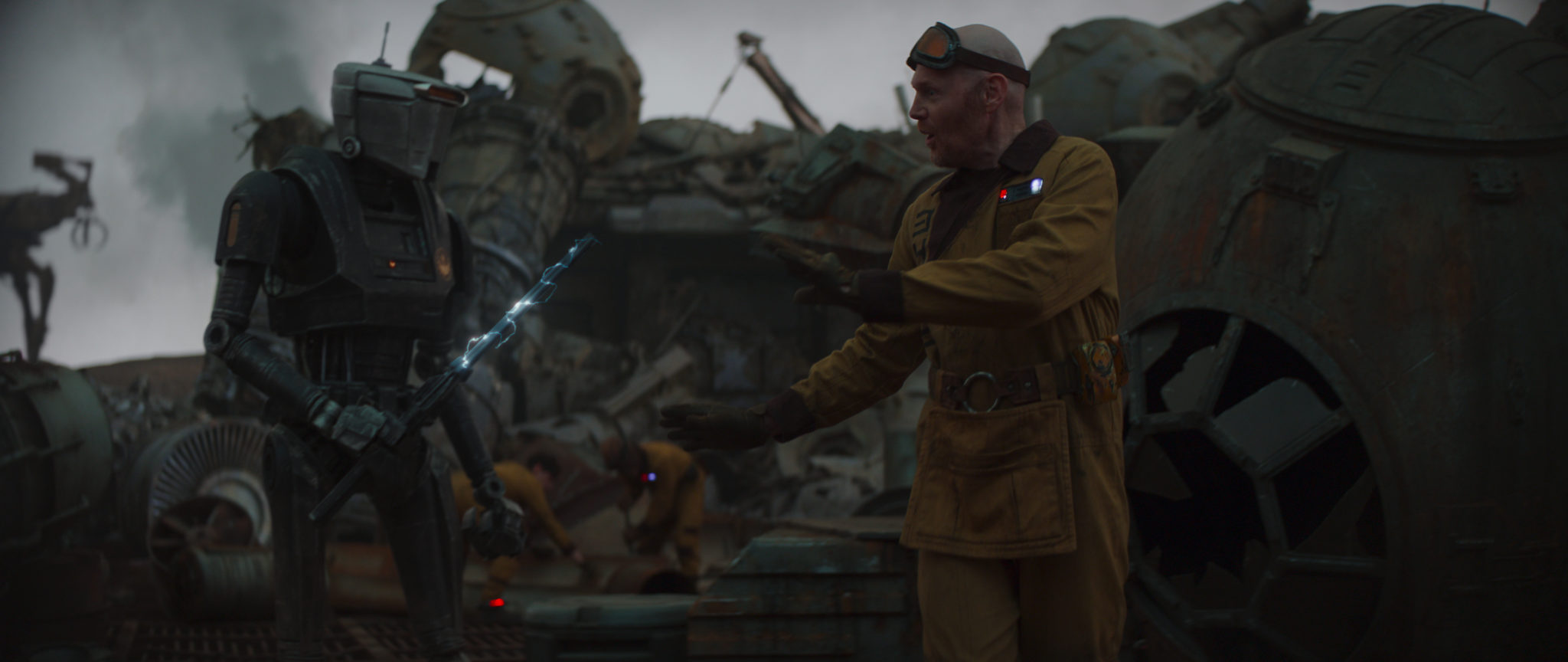


Finally, Image Engine integrated the OI-CT scrapwalker stop-motion elements received from Tippet Studio—the company helmed by Star Wars visual effects legend Phil Tippet. “Jon Favreau wanted to use stop motion as a throwback to pioneering Star Wars FX,” explains Robin. “Seeing the first takes of the stop motion elements filled us all with a sense of nostalgia. The work was well executed and dropped into the background very convincingly.”
This is the way
The Mandalorian season two is yet another Disney+ production that reveals just how exciting the new generation of at-home entertainment can be. Jon Favreau’s show boasts an array of stunning visuals at a higher level of quality than we’ve ever seen on the small screen. For Image Engine, such end quality results from an incredible and diverse amount of work from a team of very talented artists.
“I’m incredibly proud of the entire crew for pulling these sequences together,” says Robin, reflecting on the experience. “When you look at the entirety of work across all episodes, it’s a real diverse cross-section of the many things we excel at here at Image Engine: massive amounts of camera tracking and rotomation; complex paint and prep work; well-executed assets for a wide array of creatures, environments, hard-surface ships and droids; brilliant animation from subtle eye blinks to 30ft spiders crashing through ice; the team pulling out their inner DOPs for lighting design; and all of this painstakingly packaged together by an extremely capable compositing team who smashed every problem thrown at them.”
Cara adds that, along with the team’s impressive results and the overall collaborative effort, there was one other thing that made The Mandalorian season two such a great project. “I’m incredibly pleased with what we produced; the results were a massive accomplishment, and I’m proud to work alongside the great team at Lucasfilm who trust us to take it all on.
“We also had a lot more shots featuring Grogu this season—that extra level of cuteness got us through any challenges we faced!”

